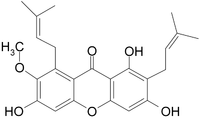- Xanthone
-
Xanthone sind aromatische Oxoverbindungen, die sich vom Ringsystem des Xanthens ableiten und in der Natur die farbgebenden Substanzen einiger Pflanzen stellen. Sie sind damit sekundäre Pflanzenstoffe, die als Farb-, Duft- und Geschmacksstoffe in Pflanzen produziert werden.
Inhaltsverzeichnis
Beschreibung
Die Grundsubstanz aller Xanthone ist das 9H-Xanthon mit der Summenformel C13H8O2. Neben ihrer Bedeutung als Farbstoffe und Antibiotika werden einige Xanthone wie das Mangostin (auch Mangostan oder Mangosteen) von Vermarktern entsprechender Produkte als sogenannte Phyto-Nutrients (gr. φυτόν, Pflanze; Nutrient, Nährstoff) bezeichnet. Das 9H-Xanthon wird als selektiv wirkendes Insektizid gegen Mottenlarven eingesetzt.[1]
Natürliches Vorkommen
Eine natürliche Quelle von etwa 40 der derzeit 210 bekannten Xanthone sind exotische Früchte aus den tropischen Regionen, die innerhalb des 20. Breitengrades wachsen, beispielsweise Früchte der Mangostane (Garcinia mangostana). Auch viele Schlauchpilze (meist flechtenbildende Lecanoromycetes) und mitteleuropäische Gentiana- (Enzian) und Aphloia-Arten produzieren Xanthone.[2] Einige Xanthone wie Cervinomycin (aus Streptomyces cervinus[3]) und Lysolipin (aus Streptomyces violaceoniger[4]) sind von Bakterien (Streptomyces) gebildete, natürliche Antibiotika.
Medizinische Bedeutung
Xanthone wurden erst seit Mitte der 1970er Jahre vornehmlich in asiatischen und amerikanischen Studien untersucht. Bestimmte Xanthone, vorwiegend Polyphenole wie etwa Mangostan (auch Mangostin) wirken im Körper antioxidativ (d.h. in Funktion als hocheffiziente Radikalfänger gegen freie Radikale); daraus resultieren bei einigen Xanthonen antibakterielle, antibiotische, anti-hepatotoxische, anti-allergische und antimykotische Eigenschaften.[5][6][7] Das 1975 erstmals beschriebene, halogenierte Xanthon-Derivat Lysolipin besitzt sowohl antibiotische Wirkung gegen verschiedenste Bakterien,[4] als auch Anti-Tumor-Aktivität.[8] Das ähnlichen Cervinomycin wurde 1986 erstmals beschrieben und wird in Form des Triacetylcervinomycin in klinischen Studien als Arzneistoff getestet.[3] Cervinomycin und Lysolipin besitzen eine dem Tetracyclin (aus Streptomyces aureofaciens) ähnliche Ringstruktur.
Einzelnachweise
- ↑ Steiner, L. F. & Summerland, S. A. (1943): Xanthone as an ovicide and larvicide for the codling moth. In: Journal of economic entomology. Bd. 36, S. 435-439.
- ↑ Wissenschaft-Online-Lexika: Eintrag zu Xanthone im Lexikon der Arzneipflanzen und Drogen, abgerufen 19. Juni 2008.
- ↑ a b A. Nagakawa, S. Omura: Structure of Cervinomycine, a novel Xantone Antibiotic against Anaerobe and Mycoplasma, in The Journal of Antibiotics, S. 301-308, Vol. XL, No. 3, 30. August 1986.
- ↑ a b H. Drautz, W. Keller-Schierlein, H. Zähner: Stoffwechselprodukte von Mikroorganismen, in Archives of Microbiology, S. 175-190, Volume 106, Number 3 / Januar 1975.
- ↑ Effect of a Mangosteen Dietary Supplement on Human Immune Function: A Randomized, Double-Blind, Placebo-Controlled Trial. 21. August 2009, Journal of medicinal food / 12 (4) 2009, pp. 755 – 763.
- ↑ Dahanukar et al.: Pharmacology of Medical Plants and Natural Products, Indian Journal of Pharmacology,p. 96 (2000).
- ↑ Mahabusarakam et al.: Inhibition of Lipoprotein Oxidation by Prenylated Xanthones Derived from Mangosteen, 33 Free Rad Res., pp. 643-59 (2000).
- ↑ Andreas Hornung: Halogenasen aus Actinomyceten, S.81, (Diss.,2005).
Weblinks
- Publikationen über Xanthone bei PubMed (engl.)
Kategorien:- Stoffgruppe
- Xanthen
- Keton
- Sekundärer Pflanzenstoff
- Lebensmittelchemie
Wikimedia Foundation.



